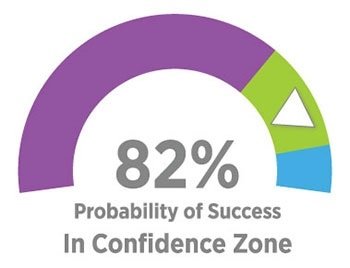Understanding Benchmarks; What Should They Mean?
When I look at what I do for clients at TAMMA, I can break it down into two distinct categories; wealth planning and asset management, and tax preparation. One of the value propositions that I offer to clients is to have their wealth planning integrated with their asset management. In my mind, you can’t or shouldn’t have one without the other. Remember, wealth planning spans vast components of both your personal and financial life such as retirement, tax, education, estate, and “lifestyle” planning to name a few.
Portfolio Management Benchmark
At TAMMA, I employ two unique benchmarks, one specifically for wealth planning and another geared towards asset management. You likely see returns for the S&P500, Dow Industrial Average, or NASDAQ splashed across all the financial and mainstream media headlines. What most people should realize but likely don’t, is that those benchmarks are awful when it comes to setting a benchmark for a balanced portfolio like those that I manage at TAMMA.Those benchmarks that I just called out only focus on U.S. equities. Would you own a portfolio that is 100% invested in U.S. equities? That would be extremely risky and could be detrimental in achieving your wealth planning goals.The custom portfolios that I build for clients are broadly diversified within sectors (different industries), but more importantly, diversified against different asset classes such as small and large-cap, international and domestic equity, bonds both international and domestic, real estate, and cash. The asset management benchmark for a given portfolio must be representative of a group of assets that represent a diversified portfolio.
Wealth Planning Benchmark
I use three Vanguard LifeStrategy Funds to benchmark client portfolio returns at TAMMA based upon the given level of risk that suits each client. Those benchmarks include the following;
- Aggressive – 70% to 80% equity / 30% to 20% fixed income
- Moderate – 60% to 70% equity / 40% to 30% fixed income
- Conservative – 50% to 60% equity / 50% to 40% fixed income
Let’s shift our attention to a benchmark used for wealth planning. While the benchmark can vary, the bottom line focus of your wealth management plan should be, are you able to achieve your desired goals?There is a very distinct difference between the asset management benchmark which is more metric centered; I achieved an actual return of X vs. the benchmark of Y vs. the wealth planning goal that is strictly goals based and did I achieve that goal.At TAMMA, I use a leading-edge software tool called MoneyGuidePro, which helps to develop a wealth management plan which can advance into customizable alternative scenarios based upon the client’s own unique needs and wants. For each scenario, the tool calculates a plan’s probability of success. The value to the client becomes selecting a realistic plan that the client can work towards to achieve their ultimate goals.Although there are never any full proof plans, I guide clients to aim for a probability of success between 70% and 90%, to begin with. Trying to predict what is going to happen five years down the road is impossible, let alone 10, 15, or 20 years.The objective is to know and understand that wealth planning and asset management require different benchmarks. It is critical to know that these benchmarks work largely independent of each other and that there is a multitude of factors that can have an impact on achieving your wealth management plans.You could beat your asset management benchmark but still fail to meet your wealth planning goals. The true measuring stick should be, can I achieve my goals, and do I have a plan in place to help me get there?

